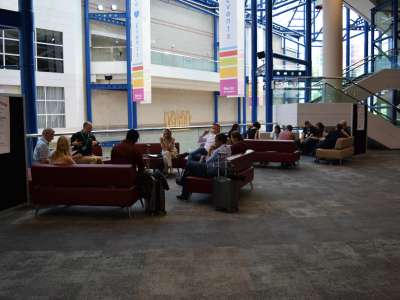
As a rehabilitation engineer I have been involved in the provision of cost-effective solutions (equipment) to people with posture and mobility problems for the past two years. I qualified as an engineer from Coventry University in 2014 and, during my placements, I was fortunate to be mentored by engineers and therapists from the West Midlands Rehabilitation Centre. Everyone there looked forward to the PMG conference as the highlight of the working year.
With the 2016 event being held in Birmingham, I was really looking forward to going back and was so grateful when I received the email from PMG confirming that my application for a bursary had been successful.
As I reflect, I would say that PMG Conference 2016 was a one stop shop! The three days were packed with different activities: there was time for networking; for learning practical ways of providing posture and mobility solutions for real life problems; and for being inspired and challenged.
I visited most of the stands at the exhibition to learn about product updates and new products, and some clients have since been assessed for new equipment that was on display at the event. I also gained clarification on technical issues I had encountered in my day to day work.
The speed networking had started the ball rolling, and I attended the session discussing head supports. One of the solutions suggested for some complex clients was to supply different head supports to meet the requirements of different activities. Almost everyone agreed that there are times when parents/carers need to make adjustments in different situations: for example, when the head support is required for a relaxed seating position at home, for feeding, or for transport. Shortly after the conference I visited a client with motor neurone disease who may well benefit from such an arrangement, and alternative adjustable head supports are to be assessed and trialled. [Photograph above shows Matthew Eveleigh leading the speed networking session on head supports; in the background Paul Dryer leads the session on transportation. Photo courtesy of Suzie Hunt.]
Case studies on the use of switch drive electric wheelchairs highlighted the difference that thinking outside the box can make to promote independence of people with posture and mobility problems. The first was a case study by V. Curling and R. Hindle involving a 5 year old with spinal muscular atrophy using fibre optic switches to drive a power chair. No force is used to activate the switches and therefore they can be used by clients with limited finger movements. In the second case study, a bespoke switch for driving a wheelchair had been developed by J. Salami. This involved a foot switch that can distinguish between voluntary and involuntary movement designed for a client with dystonic cerebral palsy (CP) to control a wheelchair. Clients with this type of CP are susceptible to muscle spasms and contractions which make it almost impossible to use other (standard) wheelchair controls. These are the first cases I have encountered where someone had successfully used such switches.
Legal guidelines were provided in the presentation Safety, equipment, restraint: mental capacity and human rights by Michael Mandelstam. I often find the use of posture belts and harnesses challenging in relation to restraint, especially for occasional wheelchair users. I now feel better informed, knowing that the legal test is about the decision-making process and justification rather than the eventual decision or action taken.
The presentation Making life better: postural management & surgery for the child and adult with complex disability by M. Gough and W. Murphy highlighted that any intervention should aim to improve function and comfort, and enhance participation. The use of posture management in the prevention of hip dislocations was discussed, and a lively debate ensued. During the debate I learnt that, not only is weight-bearing necessary for the development of the hip joint, but muscle and brain activity also need to be considered.
Stabilising the pelvis was agreed as being one of the fundamentals of good posture control. However, positioning of the legs introduced the question of whether the lower limbs should be in adduction or abduction when providing postural support. Some of the issues were raised by experienced professionals recollecting (or making comparisons with) presentations at previous PMG conferences. This highlighted that I, as a professional, need to keep an open mind and continue developing my knowledge base.
I am so grateful for the PMG bursary that enabled me to attend all the activities at this year’s well organised conference - almost everything needed for my professional development was provided in just one event! This really was an appetiser for me, and I will certainly strive to attend future PMG conferences.






.jpg)



no comments
Add your comment...